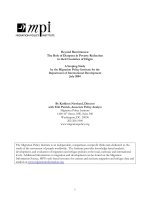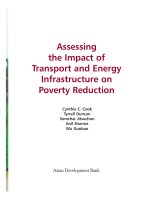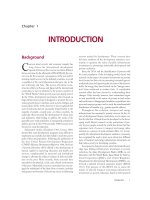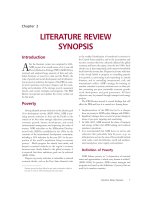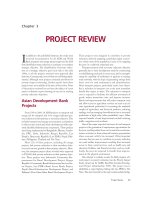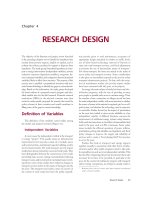The role of growth and income distribution in poverty reduction the case of the south eastern asian countries
Bạn đang xem bản rút gọn của tài liệu. Xem và tải ngay bản đầy đủ của tài liệu tại đây (1.13 MB, 81 trang )
International Institute of Social Study
University of Economics
Erasmus University of Rotterdam,
Ho Chi Minh City, Vietnam
The Netherlands
VIETNAM – THE NETHERLANDS PROGRAMME FOR M.A IN
DEVELOPMENT ECONMICS
THE ROLE OF GROWTH AND INCOME DISTRIBUTION IN POVERTY
REDUCTION: THE CASE OF THE SOUTH-EASTRN ASIAN COUNTRIES
by Hồ Quốc Tuấn
A Thesis Submitted in Partial Fulfillment of the Requirements for the Degree of
Master of Art in
Development Economics
Under the Supervision of Assoc. Prof. Dr. Nguyễn Trọng Hoài
Vietnam – Netherlands Programme, August 2013
International Institute of Social Study
University of Economics
Erasmus University of Rotterdam,
Ho Chi Minh City, Vietnam
The Netherlands
VIETNAM – THE NETHERLANDS PROGRAMME FOR M.A IN
DEVELOPMENT ECONMICS
THE ROLE OF GROWTH AND INCOME DISTRIBUTION IN POVERTY
REDUCTION: THE CASE OF THE SOUTH-EASTRN ASIAN COUNTRIES
by Hồ Quốc Tuấn
A Thesis Submitted in Partial Fulfillment of the Requirements for the Degree of
Master of Art in
Development Economics
Under the Supervision of Assoc. Prof. Dr. Nguyễn Trọng Hoài
Vietnam – Netherlands Programme, August 2013
DECLARATION
This is to certify that thesis entitled “The Role of Growth and Income Distribution in
Poverty Reduction: The Case of South-Eastern Asian Countries”, which is submitted
by me in fulfillment of the requirement for the degree of Master of Art in
Development Economic to Vietnam-The Netherlands Programme. The thesis
comprises only my original work and due supervision and acknowledgement have
been made in the text to all other material used.
Hồ Quốc Tuấn
CERTIFICATION
v
ACKNOWLEDGEMENT
I would not be possible to write this master thesis without the help and support of
people surrounding me.
Above all, I am grateful to my supervisor, Assoc. Prof. Dr. Nguyễn Trọng Hoài, for
his helpful comments and supervisions. This thesis research would not be feasible
without the advices, supports and guidance from him.
I would like to acknowledge all the lecturers at the Vietnam – Netherlands
Programme for their knowledge of all the courses, during the time I studied at the
program. Besides, I would like to thank all the academic and technical staffs of the
Vietnam – Netherlands Programme for supporting me during that time.
I would like to express my gratitude to my family, especially my parents. I would not
complete this thesis, as well as study in this program, without their scarification,
encouragement and important support. Additionally, I am also grateful to my better
half for her personal support and patience at all times, which accelerate my thesis
writing process. For the love and expectation of my family, which motivate my effort
to complete this master degree, my mere expresses of gratitude here have never been
sufficient.
Last, but not least, I thank my friends and people, who have any help and support for
my thesis but are not above-mentioned.
vi
ABBREVIATIONS
FE
Fixed Effect
GDP
Gross Domestic Product
Gini
Gini coefficient
GLS
Generalized Least Squares
GNP
Gross National Product
MDG
Millennium Development Goal
OLS
Ordinary Least Squares
P1
Poverty Headcount ratio
P2
Poverty gap index
P3
Poverty squared gap index
RE
Random Effect
vii
ABSTRACT
This thesis research contributes to exploring the impact of economic growth and
inequality on poverty. In detail, this research aims to identify the effect of income
growth on poverty and the impact of inequality on the rate at which growth reduces
poverty. This research use unbalanced-panel data for South-Eastern Asian countries in
the period from 1981 to 2010. The research argues that for all three measures of
poverty, i.e. headcount ratio (P0), poverty gap (P0) and poverty squared gap (P2)
income growth has a significant and negative impact on poverty. The estimated
growth elasticity of poverty for the whole region is -3.25 for P0, -4.00 for P1 and -4.47
for P2. Additionally, inequality as well as the level of initial inequality is found to
affect the impact of income growth on poverty reduction significantly. Higher
inequality as well as higher initial level of inequality decelerates the growth elasticity
of poverty in absolute value. Finally, the impacts of income growth and inequality are
larger on the more sensitive measures of poverty.
viii
TABLES OF CONTENTS
LIST OF TABLES ........................................................................................................ xi
LIST OF FIGURES .....................................................................................................xii
Chapter 1
INTRODUCTION ................................................................................... 1
1.1 Problem Statement ............................................................................................... 1
1.2 Research Objectives ............................................................................................. 2
1.3 Research Questions .............................................................................................. 2
1.4 Research Scope and Data ..................................................................................... 3
1.5 Organization of the Thesis ................................................................................... 3
Chapter 2
LITERATURE REVIEW ........................................................................ 5
2.1 Definitions ............................................................................................................ 5
2.1.1 Poverty........................................................................................................... 5
2.1.2 Economic Growth .......................................................................................... 6
2.1.3 Inequality ....................................................................................................... 6
2.2 The Important Role of Economic Growth in Poverty Reduction ......................... 7
2.3 Growth and Redistribution Components of Poverty Reduction ......................... 10
2.4 The Impact of Inequality on the Responsiveness of Poverty to Growth ............ 12
2.5 Analytical Framework ........................................................................................ 15
2.6 Chapter Remark .................................................................................................. 16
Chapter 3
RESEARCH METHODOLOGY........................................................... 18
3.1 Model Specification ........................................................................................... 18
3.2. Research Hypothesis ......................................................................................... 21
3.3 Measurements of Variables ................................................................................ 22
ix
3.3.1 Poverty......................................................................................................... 22
3.3.2 Inequality ..................................................................................................... 23
3.3.3 Income ......................................................................................................... 25
3.3.4 Initial Inequality and Initial Income or Consumption ................................. 25
3.3.5 Growth Rate of Poverty, Income and Inequality ......................................... 25
3.4 Data Collection ................................................................................................... 26
3.5 Estimation Strategy ............................................................................................ 27
3.5.1 The Constant Coefficients Model ................................................................ 27
3.5.2 Random Effects Regression Model ............................................................. 28
3.5.3 Fixed Effects Regression Model ................................................................. 28
3.5.4. Choosing between the FE Model and RE Model: The Hausman
Specification Test ................................................................................................. 29
3.6 Chapter Remark .................................................................................................. 30
Chapter 4
DATA ANALYSIS ................................................................................ 31
4.1 South-Eastern Asian Countries: An Overview on Poverty, Income and
Inequality .................................................................................................................. 31
4.2 Poverty, Income Growth and Inequality: The Interrelationship ........................ 32
4.3. Empirical Results .............................................................................................. 35
4.3.1 Estimation Process....................................................................................... 35
4.3.2 Choosing the Most Appropriate Model ....................................................... 36
4.3.3 Discussions on the Research Results ........................................................... 37
4.4 Estimating the Growth Elasticity of Poverty...................................................... 41
4.5 Chapter Remark .................................................................................................. 43
x
Chapter 5
CONCLUSION AND POLICY IMPLICATION .................................. 44
5.1 Conclusion .......................................................................................................... 44
5.2 Policy Implication .............................................................................................. 45
5.3 Limitation and Suggestion of Further Research ................................................. 46
REFERENCES ............................................................................................................ 48
APPENDIX A: DESRRIPTION OF THE DATASET ................................................ 53
APPENDIX B: DESCRIPTIVE STATISTICS OF VARIABLES .............................. 59
APPENDIX C: RESULTS OF HAUSMAN TEST ..................................................... 62
APPENDIX D: REGRESSION RESULTS ................................................................. 65
APPENDIX E: ESTIMATION OF GROWTH ELASTICITY OF POVERTY ......... 68
xi
LIST OF TABLES
Table 3.1 Summary of expected sign of coefficients ................................................... 22
Table 4.1 Summary of Hausman Test Results ............................................................. 36
Table 4.2 Choice between FE model and RE model ................................................... 37
Table 4.3 Summarized Estimation Results .................................................................. 38
Table 4.5 Estimation of Growth Elasticity of Poverty ................................................. 42
xii
LIST OF FIGURES
Figure 2.1 Analytical Framework ................................................................................ 15
Figure 3.1 Lorenz Curve .............................................................................................. 24
Figure 4.1 Income growth and poverty ........................................................................ 33
Figure 4.2 Inequality and poverty ................................................................................ 33
Figure 4.3 Income and inequality ................................................................................ 34
1
Chapter 1
INTRODUCTION
This chapter begins the thesis research by introducing the research topic and states the
research problems in terms of social and scientific point of view, which motivate this
thesis project. This chapter also includes the research objectives and research
questions that will be solved by the thesis. In addition, this chapter provides the
research scope of this thesis. It will end in bringing out the organization of the thesis.
1.1 Problem Statement
Reducing poverty is the first and conceivably the most important goal of the
Millennium Development Goals (MDGs). In detail, the target of the MDG1 is to
halve “the proportion of people whose income is less than $1 a day” (United Nations,
2010, p. 6) during the period 1990-2015. For the South-Eastern Asian countries, in
terms of poverty reduction, the poverty rate (measured by headcount ratio) falls from
39% in 1990 to 19% in 2005 (United Nations, 2010). This is a great achievement that
the South-Eastern Asian countries have early met the target of MDG1 in 2005, ten
years before the MDGs deadline. Moreover, although poverty in this region was
reduced sharply (more than a half during this period), there stills a large proportion of
people in these countries living on less than the poverty line. According to United
Nations (2013), the poverty rate of the South-Eastern Asia region, measured by
headcount index, is 14% in 2010. Therefore, this successful poverty alleviation
progress must be maintained. For these reasons, analyzing the sources of the
successful poverty alleviation progress of these countries is of interest in both policy
and scientific perspectives.
Economists have debated about how economic growth and declines in income
inequality can reduce poverty. In the first side of the debate, researches emphasize
that economic growth is crucially important for poverty reduction, and they neglect
the role of inequality. For example, change in poverty is attributed to the major role of
growth by Squire (1993), Bruno, Ravallion, and Squire (1998), and Dollar and Kraay
(2002). In the second line of researches, economic growth and income inequality have
been argued influence poverty together. For instance, Datt and Ravallion (1992) and
2
Kakwani (1993) decompose changes in poverty into income (growth) and distribution
(inequality) effects. The final group of thoughts argues that beside the important role
played by growth in poverty reduction, income inequality also matters because it
affects the rate at which income growth can reduce poverty. Some remarkable
researches in this group are Ravallion (1997), Collier and Dollar (2001), Ravallion
(2001), Adams (2004), Fosu (2008) and Heltberg (2002), who discuss that the growth
elasticity of poverty strongly depends on the level of inequality.
In light of these conflicting points of view, this thesis is intending to identify the role
of economic growth and inequality in terms of poverty reduction in the case of SouthEastern Asian countries. This thesis pays attention on the South-Eastern Asian
countries because of their successful progress of fighting poverty.
1.2 Research Objectives
The thesis aims to identify the role played relatively by growth and inequality in
poverty reduction. In other words, it intends to analyze the impact of growth and
inequality in poverty. In particular, this thesis has two main research objectives:
(i) To analyze the extent to which growth can affect poverty by using of elasticity
approach
(ii) To identify how inequality can affect the relationship between growth and poverty
by considering a function of growth elasticity of poverty
For the first objective, this research aims to estimate the growth elasticity of poverty,
which shows how much poverty will decrease if income increases by 1 per cent. The
second purpose of this thesis is to identify the impact of inequality on the
responsiveness of poverty to income growth. This indicates how the growth elasticity
of poverty can be affected by changes in inequality.
1.3 Research Questions
This thesis aims to answer two questions:
(i) How much can economic growth reduce poverty?
3
(ii) How can inequality affect the ability of growth to reduce poverty?
1.4 Research Scope and Data
This thesis concentrates on the South-Eastern Asian countries because of two reasons.
Firstly, the region is more successful than some other regions of the world in poverty
reduction from 1990 to 2010. For instance, according to United Nations (2013), the
Sub-Saharan Africa reduces poverty rate from 56% to 48%, Southern Asia from 51%
to 30%, Latin America from 12% to 6%, and all developing countries from 45% to
22%. These amounts of reductions (in relative means) are smaller in comparison with
the South-Eastern Asia region, which achieves the reduction from 45% to 14% over
the same period. The second reason is that there still being almost one fifth of the
population of this region still living below $1.25 a day in 2010 (United Nations,
2013). Hence, the root cause of poverty reduction in this region must be considered in
order to perform effective policy in favor of maintaining poverty alleviation and
improving well-being of the poor.
The empirical analysis section of the thesis will be implemented by employing
unbalanced panel data from 8 countries in the South-Eastern Asia region over the
period from 1981 to 2010. The data was collected from ‘PovcalNet: the online tool for
poverty measurement developed by the Development Research Group of the World
Bank’.
1.5 Organization of the Thesis
This thesis includes five chapters, which are organized as follow:
Followed by this introductory chapter, chapter 2 will survey the literatures in the
debate about the role of growth and inequality in poverty reduction. As mentioned
above, there are three sides in the debate. In terms of poverty reduction, the first side
emphasizes the role of growth, the second side equalizes the role of growth and
inequality by decomposing poverty reduction into growth and distribution
components, whereas the final side clearly states that inequality affects the ability of
growth in poverty alleviation. Literatures will be reviewed as they belong to one of
these groups depending on their findings. Chapter 2 will end with an analytical
framework.
4
The third chapter will present the research methodology of the thesis. At the
beginning, this chapter will introduce an empirical model that will be used in the
thesis. Then, it will provide research hypotheses that will be tested by using the data
analysis in the following chapter. This chapter will also bring out the measures of
variables and data collection method. It will finally state the estimation strategy which
is the methods of panel data regression.
Chapter 4 will bring out the findings of this thesis research that obtained from the
estimation results. This chapter also analyzes how the research results can answer the
research questions arisen in the introduction chapter and how the research hypotheses
in chapter 3 will be tested.
The final chapter is chapter 5, which will discuss about some concluding remarks.
Based on the findings from chapter four, this chapter will also suggest some policy
recommendations for poverty reduction strategy in South-Eastern Asian countries.
5
Chapter 2
LITERATURE REVIEW
This chapter will survey the literatures on the interrelationship between growth,
inequality and poverty. It will firstly provide definitions of the related terms and key
concepts. This chapter will then review literatures based on their findings about the
growth-poverty-inequality interrelationship. As mentioned in the previous chapter,
there has been a debate between three sides of researches and three corresponding
arguments about the role of growth and changes inequality in poverty alleviation.
Three main sections in this chapter would be associated with three arguments of the
sides in this debate. Each of these sections will survey the studies that support the
argument of the respective side in the debate. The present chapter will end with an
analytical framework based on which this thesis perform its empirical study.
2.1 Definitions
This section will introduce the definitions of poverty, growth, inequality and some
other relevant concepts that will be used in the analysis of this thesis.
2.1.1 Poverty
Although there are different definitions of poverty, the most widely accepted
definition was made by World Bank (1990). In this report, poverty is defined as “the
inability to attain a minimal standard of living” (World Bank, 1990, p. 26). To make
this definition more clear, it must be necessary to understand the way to measure
standard of living and the implication of “a minimal standard of living”. Standard of
living is a multi-dimensional concept that includes wealth, health, life expectancy,
literacy and access to public goods and other resources. Among these, income and
expenditure per individual are acceptable measures of living standard even though
neither measure can capture other dimensions of welfare (World Bank, 1990). Using
monetary, i.e. income and expenditure, measures of standard of living, a poverty line
can be considered a proxy for minimal standard of living. This is because a poverty
line almost consists of the income or expenditure that are essential to buy a “minimal
standard of nutrition and other basic necessities” (World Bank, 1990).
According to Asian Development Bank (1999, p. 5):
6
Poverty is a deprivation of essential assets and opportunities to which every
human is entitled. Everyone should have access to basic education and
primary health services. Poor households have the right to sustain themselves
by their labor and be reasonably rewarded, as well as having some protection
from external shocks. Beyond income and basic services, individuals and
societies are also poor - and tend to remain so - if they are not empowered to
participate in making the decisions that shape their lives.
This thesis uses the income aspect of poverty. This implies that it does not concern
with other dimensions of welfare that go along with the definition of poverty, such as
health care services, education, etc. Because of this problem and the limitation of data
in other aspects of standard of living, the monetary indicators of poverty will be
employed in this thesis.
2.1.2 Economic Growth
Economic growth or growth, in short, is a widely popular concept defined as an
expansion in the economy of a country (Soubbotina & Sheram, 2000). Growth usually
refers to an increase in income or per capita income of an economy. In particular,
economic growth can be conceptualized as an increase in GDP or GNP (as well as
their per capita measures) that is calculated in relative or percentage means. In
addition, growth rate of an economy was calculated as a percentage increase in the
income of a country. Thus, the higher growth rate is, the larger the increase in income
of a country is.
2.1.3 Inequality
According to Litchfield (1999, p. 1), inequality is defined as “a dispersion of a
distribution, whether that be income, consumption or some other welfare indicators or
attributes of a population”.
As discussed by World Bank (2013), in analysis, inequality refers to “relative”
poverty because it mentions about “having a little in a specific dimensions compared
to other members of society”.
In other words, inequality concerns how total welfare can be distributed to individuals
and households in a society. As mentioned above, social welfare is a multi-
7
dimensional concept that includes wealth, health, life expectancy, etc. However,
except for income and expenditure, other dimensions of welfare could not be
measured easily. As a result, like many other researches, this thesis treats inequality as
it concerns about income inequality that is how total income of an economy is
distributed to its households and individuals. If a country experiences a large
difference between income of the poorest group and the richest group of people, it can
be said to face high inequality, and vice versa.
The definitions and concepts have been explained in this section. The next three
sections will survey literatures mentioned about the poverty-growth-inequality
interrelation.
2.2 The Important Role of Economic Growth in Poverty Reduction
In the first line of researches on the debate about the poverty-economic growthinequality interrelationship, researchers emphasized the role of economic growth,
rather than changes in income distribution, in poverty alleviation. In terms of poverty
reduction, many authors argue that economic growth is the main source and the
important tool for reducing the incidence of poverty. In this section, some empirical
researches of authors who stressed the role of growth, called “growth optimists”
(Heltberg, 2002), for example Fields (1989), Squire (1993), Ravallion (1995),
(Ravallion & Chen, 1997) Bruno et al. (1998) and Dollar and Kraay (2002), will be
discussed.
Fields (1989) aimed to explore the poverty-growth-inequality interrelation by
empirically testing his seven hypotheses about the interaction among these concepts
with the data from “a research project on the political economy of poverty, inequality
and growth” (Fields, 1989, p. 167) by World Bank in 1985. The evidence showed no
systematic tendency for inequality to increase or decrease with income growth.
Another result of Fields (1989) is that there is no evidence supporting for the
argument that inequality tends to increase more rapidly in the early stages of
development than in the later stages. The above findings are considered the rejection
of Kuznets hypothesis, which stated that income inequality will increase in the early
stage of growth and then it will start to go down, or the relationship between
inequality and growth is represented by the inverted U-shape (Kuznets, 1955). In
8
addition, Fields (1989) found supporting evidences for the reduction in poverty
associated with income growth. Growth was treated as the major explanation for the
decrease in poverty, as in his writing “economic growth nearly always is associated
with a reduction in absolute poverty” (Fields, 1989, p. 177).
Similarly rejecting the Kuznets hypothesis and assuming that income distribution is
relatively stable over time, Squire (1993) performed an empirical research argued that
changes in poverty were mainly affected by change in mean income or consumption.
Using a data set that involves 21 developing countries, this paper obtained the growth
elasticity of poverty about -0.24, which can be interpreted as if growth in mean
expenditure increases by 1 percentage point, the growth rate of poverty (measured by
headcount index) will decrease by 0.24 percentage points. Squire (1993) also stated
that countries with the growth rate excess of 3% per year faced sharp declines in
poverty measured by headcount index whereas in countries of which the growth rate
is less than 1%, the decrease is modest and in countries with negative growth rate,
poverty increase. Nevertheless, this research experienced the two main drawbacks.
The first one is the lack of some alternative measures of poverty, i.e. poverty gap
index and squared gap index. Secondly, due to the assumption of stable income
distribution, it neglects the role of inequality in poverty reduction.
An empirical research that aims to test the impact of growth on poverty and inequality
was done by Ravallion (1995). Using data from developing countries in the 1980s,
this study obtained a strong negative correlation between poverty and average living
standards or average income. This paper also rejected the Kuznets hypothesis as it
found that there was no tendency for inequality to increase or decrease with economic
growth within developing countries (Ravallion, 1995). However, this research faces
some problems. Firstly, based on the regressions results obtained in this paper, there
stills a noticeable variance in poverty that cannot be explained in the regressions.
Secondly, because of the employed cross-countries data, this paper did not consider
the trend of increasing average income, which should be considered in order to
explain variations in poverty.
Ravallion and Chen (1997) tested the claim that the incidence of poverty was more
serious in the 1990s despite average income of countries increased at this time. The
data used is the household surveys data from 67 developing countries over the world.
9
This study found no support for the argument that distribution tends to worsen as
average living standard grows in developing countries. Consequently, it rejects the
Kuznets hypothesis. Moreover, the evidences of this paper also showed that there was
neither a correlation between growth in average consumption and inequality nor an
underlying trend of inequality. Because inequality was stable in 1990s, Ravallion and
Chen (1997, p. 380) concluded that “there is a strong association between the rate of
growth in average living standards and the rate at which absolute poverty fell”.
The Kuznets hypothesis was also tested and rejected by an empirical study of Bruno
et al. (1998) with various type of data including cross-country, time series and panel
data. In the first part of the testing process, the authors used cross-countries data set
conveys 44 developing countries. With this data, they found no evidence of an
inverted U-shape relation between income inequality and growth. In the next stages of
the testing, Bruno et al. (1998) employed panel data from Deininger, Squire, and
Zhang (1995) and time-series data from Ravallion and Datt (1996). The results show
that “92 per cent of the variation in Gini indices by country and date is accounted for
by cross-countries variation whereas only 7 per cent is accounted for by variation over
time” (Bruno et al., 1998, p. 5). In short, neither type of data indicates the inequalitygrowth relationship suggested by Kuznets (1955). The rejection of the Kuznets
hypothesis leads to an important conclusion that there does not exist any systematic
trend for income inequality to increase or decrease with growth (Bruno et al., 1998).
Hence, on average, absolute poverty will fall with increase in income. In other words,
economic growth was considered the main tool for fighting poverty.
Dollar and Kraay (2002) shared the same view with the authors mentioned earlier of
Kuznets hypothesis. They rejected Kuznets hypothesis with the argument that they
found no evidence for that the relationship between growth and inequality is
statistically and significantly different in developed and developing countries.
Moreover, the results of Dollar and Kraay (2002) shows that the share of income of
the poor does not change systematically with changes in income. Strictly speaking,
one can say that the gains of the poor and non-poor from increase in income were held
to be constant over time, based on the results of Dollar and Kraay (2002).
Consequently, income of the poor increases as average income of a country grows,
provided the poverty line does not change. Therefore, as Dollar and Kraay (2002)
emphasized, growth is important for poverty reduction.
10
In summary, many authors have paid their attention on the Kuznets hypothesis when
trying to explore the interrelationship between poverty, growth and inequality. In this
section, some researchers, for instance Fields (1989), Dollar and Kraay (2002), Squire
(1993), Ravallion (1995), Ravallion and Chen (1997) and Bruno et al. (1998), have
employed various data in order to test the Kuznets hypothesis. They have obtained the
same result, which is the rejection of the hypothesis. Based on the rejection, they
argued that instead of changing systematically with growth, inequality is rather
relatively stable over time. The rejection of the Kuznets hypothesis allows researchers
to conclude that the poor actually gains from the increase in aggregate income
proportionately. Based on this conclusion, researchers have emphasized that
economic growth is an important source of poverty reduction. The next section will
discuss about the second side in the debate that have concentrated on the two
components of changes in poverty, growth component and distribution component.
2.3 Growth and Redistribution Components of Poverty Reduction
In the second side of the debate on the impacts of growth and inequality on poverty
reduction, researchers have decomposed changes in poverty into income (growth) and
distribution (inequality) components. The quantification of poverty reduction has been
developed by Datt and Ravallion (1992), Kakwani (1993) and White and Anderson
(2001). As will be discussed below, these authors have applied the similar
methodology of the decomposition. However, the results have been quietly different
when considering whether growth or inequality played the major role in poverty
alleviation.
A theoretically quantitative method of decomposing changes in poverty into growth
and redistribution components was developed by Datt and Ravallion (1992). This
study defined the “growth component” as the change in poverty due to a change in
income holding distribution constant, and the “redistribution component” as the
change in poverty due to a change in distribution holding income constant (Datt &
Ravallion, 1992). The decomposition allows the authors to measure thoroughly the
contribution of distributional changes and growth to poverty reduction. In the article,
Datt and Ravallion (1992) then applied the decomposition method to analyze poverty
reduction in Brazil and India. Comparing changes in poverty in the two nations in the
1980s, this research indicated that poverty reduction in India was mainly contributed
11
by decrease in inequality. By contrast, in Brazil within the same period, poverty
reduction was largely due to economic growth. However, the method of
decomposition may face a problem resulted in by defining the growth and
redistribution components in condition that distribution and income are stable
relatively. Thus, the method cannot explain such a case of growth with falling
inequality.
Using the same measures of poverty, inequality and growth, Kakwani (1993)
constructed a similar theoretical methodology to decompose a change in poverty into
a change in average income and a change in income inequality, called growth
component and distribution component. The impacts of each component on poverty
reduction was quantified separately in this method in order to explore whether growth
or better distribution (in the view of the poor) is the primary cause of the reduction in
poverty. Relying on the breakdown of change in poverty, Kakwani (1993) developed
the formulas for calculating the growth elasticity and inequality elasticity of poverty.
The method was then applied in exploring the poverty reduction of Cote d’Ivoire in
1985. This paper calculated the growth elasticity and inequality as follow: with the
91,394CFAF (the Cote d’Ivoire national currency unit) poverty line, the growth
elasticity was -2.87 and the inequality elasticity was 7.86; with the 162,613CFAF
poverty line, they are -1.54 and 1.70 relatively (Kakwani, 1993). These results were
calculated in case of the headcount ratio measures of poverty. In case of other
measures, the author obtained similar results, means higher inequality elasticity in
comparison with growth elasticity (in absolute value). In short, despite the levels of
poverty line and the poverty measures, it is undoubted that poverty in Cote d’Ivoire in
1980s is more sensitive to changes in income distribution than to economic growth.
From a different point of view, White and Anderson (2001) saw poverty as in a
general picture about the pattern of growth. This paper supported the “growth versus
distribution” dichotomy. For poverty reduction analysis, White and Anderson (2001)
concentrated on the growth of the income of the poor and constructed a
decomposition analysis based on the growth function of the poor’s income. To
examine the discrimination between growth and distribution in terms of poverty
reduction, the income growth of the poor was broken down into the impacts of overall
growth and of changes in income distribution. The growth regressions for each
quintile of income distribution were then estimated in order to achieve the
12
contribution of each impact to the increase in income of the poor. Although in more
than a quarter of cases changes in inequality played a more important role, White and
Anderson (2001) indicated, in a total of 143-countries cases, the growth impact
dominated the distribution impact in contributing to reduce poverty. This finding
conflicts with the result obtained by Kakwani (1993), which stated that the more
important role in poverty reduction was played by the distribution component. The
confliction between these results can be explained by the difference in data used, Cote
d’Ivoire in Kakwani (1993) and global data in White and Anderson (2001).
This section can be summarized as a “growth versus distribution dichotomy” in the
explanations of poverty reduction. The authors in this line of researches have
decomposed changes in poverty into growth and distribution effects. Separately, the
researchers have found different major sources of poverty alleviation due to the
different data. Kakwani (1993) argued that the role of decrease in inequality
dominated, whereas the growth effect was found to dominate by White and Anderson
(2001). Similarly, Datt and Ravallion (1992) found that in Brazil the major role in
poverty reduction was played by growth and in India, it was played by distribution.
The final section of the literature review will deal with the final side in the povertyreduction debate, which aims to oppose the growth versus distribution dichotomy.
2.4 The Impact of Inequality on the Responsiveness of Poverty to Growth
In the third side of the debate over growth, inequality and poverty, researchers made
an agreement with the first side mentioned in the first section, that income growth
played a stronger role in poverty alleviation. However, what makes the difference is
that researchers, for instance Ravallion (1997), Ravallion (2001), Heltberg (2002),
Adams (2004) and Fosu (2008, 2009, 2010a, 2010b, 2010c, 2011), argued that
inequality also matters because it rather affects the extent to which growth can reduce
poverty than impact directly on poverty.
Ravallion (1997, p. 3) introduced a regression function concerns with the argument
that initial inequality can affect the rate of poverty reduction, called “growth elasticity
argument”. This paper tested the hypothesis that the responsiveness of the rate of
poverty reduction to growth would become smaller as inequality increased and
poverty would be unresponsive to growth if inequality were sufficiently high. Using
13
data from 23 developing countries, the evidence indicated that the tested hypothesis
could not be rejected. Hence it is reasonable to state that “higher inequality tends to
entail a lower rate of poverty reduction at any given rate of positive growth”
Ravallion (1997, p. 7). Moreover, the article found that the growth elasticity of
poverty decreases sharply as inequality rises. Consequently, initial inequality does
influence how much will the poor gain from growth, or by how much will income of
the poor increase as aggregate income increases. The higher initial inequality is, the
less strong the impact of growth on poverty reduction is.
The question of how inequality matters the growth-poverty relationship was
fundamentally analyzed by Ravallion (2001). Employing data from household
surveys, Ravallion (2001) also declared that the poor actually share in the benefits of
increasing average income of a country. However, the differences in initial inequality,
both global and national, resulted in differences in how much the poor gain from the
income expansion (Ravallion, 2001). In this study, the effect of inequality on the
responsiveness of poverty to growth was explored as twofold. Firstly, the evidence
tends to support the argument that inequality is harmful for growth. Thus, lower
inequality is expected to encourage economic growth and hence to reduce poverty due
to the increase in income of the poor gained from aggregate income growth.
Secondly, based on the estimated growth elasticity of poverty, the paper found that
the elasticity decreases considerably as the extent of initial inequality increases. As a
result, at any given rate of income growth, countries with rising inequality experience
the lower rate of poverty reduction, whereas in countries with more equal distribution
of income, poverty declines at a higher rate. This result is similar to that obtained by
Ravallion (1997).
Heltberg (2002) theoretically analyzed the poverty-growth-inequality interrelationship
by using a different methodology - synthesizing studies in this field. Similar to many
other researches, this paper traced economic growth as the main engine for poverty
reduction. The research also rejected the decomposition of changes in poverty into
growth and distribution components, or the growth versus distribution dichotomy.
Despite growth is considered a necessary condition for poverty alleviation, the level
of inequality and its changes also matter (Heltberg, 2002). However, the impact of
inequality cannot be in the same position with economic growth. This is due to
inequality strongly effects the growth elasticity of poverty, and initial inequality
